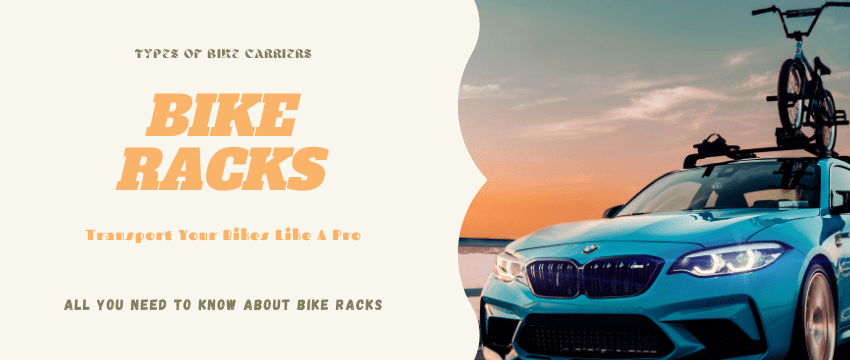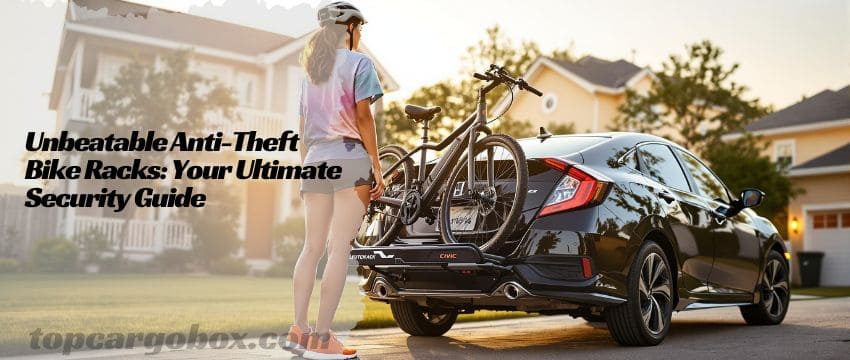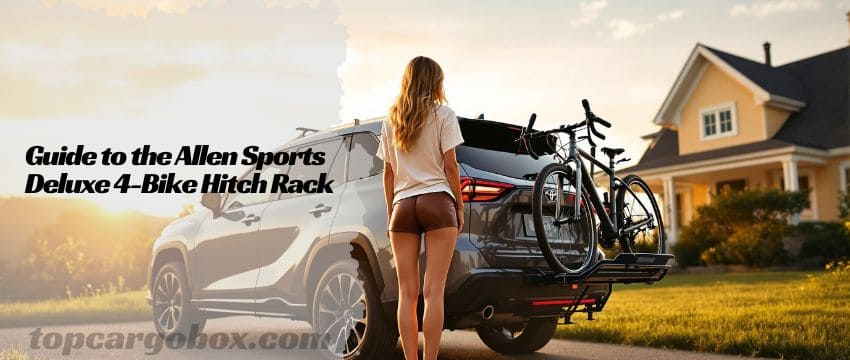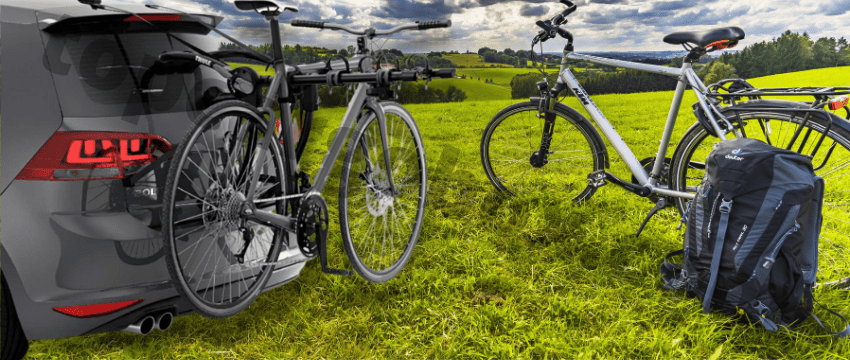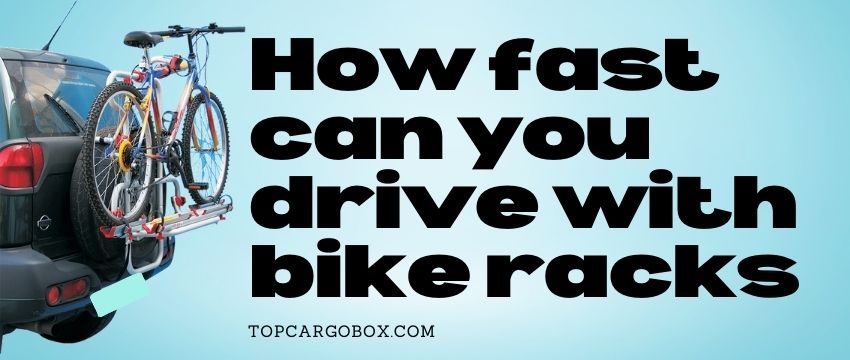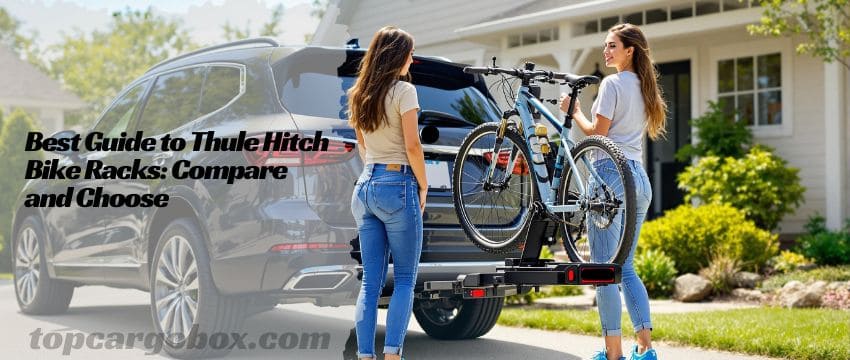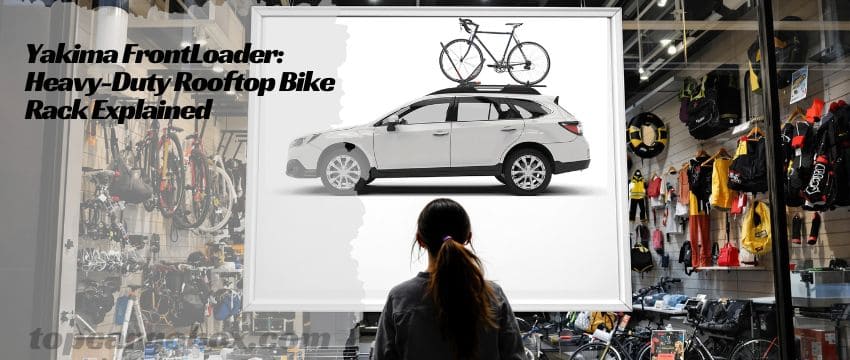Hey there, fellow adventurer with the compact ride! Looking for bike racks? Ever looked longingly at your bike, then at your small car, and thought, “How on earth am I supposed to get that thing to the trails?” Totally get it. Trying to cram a bike into the trunk of a Honda Civic or a Toyota Prius feels like playing a losing game of Tetris. It sucks, right? And maybe you’ve seen those massive hitch racks on SUVs and wondered if anything that size could possibly fit your little hatchback without looking ridiculous or, worse, scraping the ground. What if I told you there are legit solutions out there designed specifically for folks like us? Awesome, right? Forget the frustration – let’s dive into the world of space-saving bike racks that actually work with small cars, so you can finally hit the road (or trail) without a grunt.
Quick-Pick List of 6 Bike Racks For Small Cars:
Image | Items | Links |
|---|---|---|
 | Allen Sports 102DN-R Trunk Rack (Red/Black): Red and black trunk-mounted rack carrying two bikes with 12″ arms, padded frame guards, and stabilizing side straps (70 lb total capacity). | |
 | Allen Sports 102DB Trunk Rack (Black/Silver): Black and silver universal trunk rack featuring a quick-setup design, 12″ carry arms for two bikes, and patented tie-downs (70 lb capacity). | |
 | Saris Bones 2-Bike Trunk Rack (Black): Black Saris Bones rack with iconic arc design, anti-sway straps, rust-free composite frame, holding two bikes (35 lb each). | |
 | Saris Solo 1-Bike Trunk Rack (Black): Compact, foldable black Saris Solo rack for one bike, made from recyclable plastic with ratcheting straps and zero adjustments needed. | |
 | Allen Sports Premier S102 Trunk Rack (Black): Black Allen Premier trunk rack with patented quick-snap setup, dual-compound tie-downs, and large pads for two bikes (70 lb capacity). | |
 | SportRack Back-up 3-Bike Trunk Rack (Black): SportRack trunk carrier holding three bikes with adjustable straps, protective padding, folding arms, and 132 lb total capacity. |
Why Small Cars Need Special Rack Consideration
Okay, let’s be real for a sec. Small cars aren’t just scaled-down versions of bigger ones. They come with unique challenges that make choosing a bike rack way more critical. First off, ground clearance. Your sweet little ride probably sits lower than a truck or SUV. A hitch rack designed for a monster truck? Yeah, that’s gonna drag on every driveway and speed bump. Not cool, and potentially damaging. Secondly, weight distribution matters big time. Adding a heavy rack and a couple of bikes to the very back of a lightweight car can affect handling more than you might think. Ever felt the rear end get a bit squirrelly? Adding weight way back there amplifies that feeling. Third, access! Your trunk or hatch is your lifeline. A bulky rack that blocks it completely? Forget grabbing your picnic basket or gym bag easily. That’s a major bummer. Finally, let’s talk aesthetics and proportions. A massive, overhanging rack on a Mini Cooper looks, well, off. You want something that fits the car’s vibe, not overwhelms it. Finding a rack that balances all these factors? It’s not impossible, but it requires some smart shopping. Check out our deep dive on why you need bike racks to understand the core benefits before we get into the specifics for your ride.
Top Bike Rack Types for Tiny Trunks & Low Profiles
Alright, so what are your actual options? Don’t sweat it, we’ve got you covered. The key is focusing on racks that minimize bulk and maximize compatibility with smaller frames and hitches. Let’s break down the main contenders:
- Trunk-Mounted Racks: The Budget-Friendly Fold-Away. How’s it going for your wallet? If you’re looking for the most affordable and generally easiest solution to start with, trunk racks are often it. They use straps to hook onto your trunk lid or hatch. The big win? They usually fold down pretty compactly when not in use, so storage in your apartment or garage is no big deal. Models like the Jayeuw Trunk Bike Rack are popular for this. But, there are downsides. They can sometimes wobble a bit more than other types (though we have tips for preventing bike rack swaying), and accessing your trunk requires unlatching the rack. Also, they rely on your car’s specific contours, so compatibility isn’t always guaranteed – always double-check the fit guide! For small cars like the Toyota Prius or Mini Cooper, specific trunk rack models are proven winners.
- Hitch-Mounted Racks: The Stable & Accessible Champ. So, does your small car have a hitch receiver? Even a small Class I (1.25-inch) hitch opens up a world of super stable options. Hitch racks are generally the gold standard for security and ease of use. The best part? Many feature a tilt or swing-away mechanism. This means you can easily access your trunk or hatch without taking the bikes off! Game-changer, right? Brands like Thule and Yakima offer models specifically designed for lighter vehicles and smaller hitches, such as the Thule Apex XT 4 or the Yakima RidgeBack. Stability is usually excellent, minimizing that worrying wobble feel. Check out our comparison of trunk vs hitch wobble for more. While often pricier than trunk racks, the convenience and stability are totally worth it for frequent riders. Need help choosing between hitch rack styles? Our guide on hitch or trunk bike racks breaks it down.
- Roof-Mounted Racks: The Space-Saver (But Height Adder). Roof racks are undeniably space-efficient on the car – they don’t extend the length or block the trunk. If you already have roof bars (like many Subarus come with), adding bike carriers is straightforward. However, there’s a major catch for small cars: height. Lifting bikes onto the roof of a low sedan is a serious workout, and you need to remember the bikes are up there (garage door clearance, anyone? Ouch!). Plus, roof racks create significant wind resistance, which hits your MPG harder than other rack types. For very small cars, the height addition can also feel awkward. They are a valid option, especially if you value trunk access and don’t mind the lift, but they aren’t always the first choice for compact vehicles. Explore all the types of bike racks for a full picture.
- Spare Tire Mount Racks: The Niche Solution. Got a rear-mounted spare tire, like on some older SUVs or Jeeps? There are racks designed to clamp directly onto that spare. While less common for typical small cars, if your specific model does have a rear spare, this can be a super sturdy and convenient option that keeps the rack profile tight to the vehicle. Just ensure your spare is securely mounted and the rack is compatible.
Top Space-Saving Picks for Your Compact Ride (Real Talk!)
Enough theory! Let’s talk specific racks that have proven themselves on the backs of small cars. These picks prioritize compact design, compatibility, and stability. Off the top of my head, based on real user experiences and specs:
- Saris Bones EX (Trunk Mount): Dude, this is a classic for a reason. The Bones design is iconic, known for its three-point contact system that hugs your car’s contours securely. The EX version adds extra stability arms. It folds down incredibly flat for storage, works on a huge range of hatchbacks and sedans (including tricky ones like the Prius), and carries up to 3 bikes. It’s relatively light and the arms don’t touch your bike’s frame. A legit, reliable choice if trunk mount is your jam. Our Saris Bones guide has the full scoop.
- Thule T2 Pro XTR (Hitch Mount – 1.25″): Yeah, Thule is fancy, but hear me out. The T2 Pro XTR is a beast in stability and features, but comes in a 1.25″ hitch version perfect for small cars. Why is it space-saving? It folds up vertically when not holding bikes, taking up minimal space behind your car. The tilt-down trunk access is smooth as butter, and it holds bikes rock-solid. It handles heavier bikes (like e-bikes) with ease thanks to its robust construction. Perfect for Subaru Crosstrek or Impreza owners. See how it stacks up in our best Thule hitch racks comparison.
- Allen Sports Deluxe Hitch Rack (2-Bike) (Hitch Mount – 1.25″): Looking for great value without sacrificing too much stability? The Allen Sports Deluxe series offers surprisingly solid hitch racks at a friendlier price point. Their 2-bike model for 1.25″ hitches is a common sight on compact cars. It folds up reasonably well and often includes a tilt feature. While maybe not as ultra-premium as Thule or Yakima, it gets the job done reliably for most riders on a budget. Check out the Allen Deluxe 4-Bike for larger capacity options too.
- Jayeuw Platform-Style Trunk Rack: Need a trunk rack that feels more like a platform? Jayeuw offers designs that cradle the bike wheels, avoiding frame contact. They often fold very compactly and are known for being relatively easy to install and remove. A good middle-ground option if you want better bike support than traditional hanging trunk racks but aren’t ready for a hitch. Find the Jayeuw trunk rack specifics here.
- Swagman XC Cross Country (Hitch Mount – 1.25″): This is a straightforward, no-nonsense hanging hitch rack. It’s lightweight, folds up fairly compactly, and is known for its ease of use. The XC model is simple to load and unload and provides good value. A solid choice if you want hitch stability without extra bells and whistles. Get the details on the Swagman XC.
- MaxxHaul 50025 (Hitch Mount – 1.25″): Another value-focused hitch rack contender. The MaxxHaul 50025 is popular for its affordability and basic functionality. It folds and tilts, making it suitable for small cars with limited space behind the hitch. A decent entry point into the world of hitch racks. See the MaxxHaul 50025 specs.
Key Features & Specs That Matter BIG TIME for Small Cars
Choosing isn’t just about the type or brand; it’s about the nitty-gritty details that make or break the experience on a compact vehicle. Don’t just glance at the box – dig into these specs:

Essential Small Car Bike Rack Specs
Feature | Why It Matters for Your Small Car | What to Look For |
|---|---|---|
Hitch Size (if applicable) | Your car likely only has a small receiver (Class I). | 1.25-inch receiver compatible. Avoid 2-inch-only racks unless you use an adapter (check weight limits!). |
Rack Weight | Lighter racks put less strain on your small car’s rear end and are easier to handle. | As light as possible while still being sturdy. Compare models! |
Folded/Collapsed Dimensions | Crucial for storage in small apartments/garages and reducing visual bulk on the car. | Compact fold (vertical for hitch racks, flat for trunk racks). Measure your storage space! |
Ground Clearance | Prevents scraping driveways, speed bumps, and steep angles. Hitch racks are the main concern. | High clearance design or tilt functionality to angle the rack up when needed. |
Tilt/Swing Mechanism (Hitch) | Essential for accessing your trunk/hatch without removing bikes! A non-negotiable for most. | Smooth, easy tilt or swing-away. Ensure it works with your car’s trunk opening height. |
Weight Capacity (Total & Per Bike) | Small car hitches have lower limits. E-bikes are heavy! | Check rack total capacity & max per bike. Ensure it’s under your car hitch’s max tongue weight (find this in your manual!). |
Bike Compatibility | Fat tires? Step-thru frames? Heavy e-bikes? Not all racks handle them well. | Wheel holders adjust wide, cradles accommodate frame shapes, high per-bike weight limit if needed. |
- Hitch Receiver Size (Class I vs. Class II): This is HUGE. Most small cars are equipped with a Class I hitch receiver, which is 1.25 inches. Some might have a Class II (2 inches). Do not assume! Check your vehicle specs or look at the hitch itself. Buying a rack designed only for a 2-inch hitch for your 1.25-inch receiver means you’ll need an adapter, which adds complexity and reduces the overall weight capacity – and you must stay within your hitch’s limits. Seriously, exceeding this is dangerous. Our guide on bike rack weight limits is essential reading.
- Weight Capacity (Rack & Hitch): Speaking of weight, there are two crucial numbers: 1) The rack’s total carrying capacity, and 2) Your vehicle hitch’s maximum tongue weight. The tongue weight limit is the absolute max downward force your hitch can handle (rack weight + bike weight). For small car Class I hitches, this is often around 200 pounds. A heavy rack plus two heavy e-bikes can easily exceed that! Always, always check both the rack specs and your car’s hitch specs. Don’t risk it! For e-bikes specifically, see our e-bike rack recommendations.
- Ground Clearance & Approach Angles: How low does the rack sit when installed? A rack hanging super low might scrape on steep driveways or speed bumps. Some hitch racks have high-clearance designs or allow you to tilt the entire rack assembly upwards when not loaded to gain extra inches. This feature is golden for small cars.
- Folding/Collapsing Mechanism: How small does the rack get when you’re not using it? Hitch racks that fold up vertically against the car (like the Thule T2) or trunk racks that fold flat are winners for minimizing the space they occupy, both on the road and in your garage. That folded dimension matters way more when storage is tight.
- Tilt/Swing Functionality (Hitch Racks): As mentioned, this is almost essential for small cars to access the trunk. But how easy is it to tilt? Does it require unlatching bikes first? Does it swing completely out of the way? Test the mechanism if possible, or read reviews specifically about how well it works with hatchbacks/sedans.
- Bike Compatibility (Tire Sizes, Frame Styles): Not all racks play nice with fat tires, step-thru frames, kid’s bikes, or heavy downhill rigs. Ensure the rack you choose can securely hold the specific types of bikes you own. Wheel trays that adjust widely are helpful.
Installation & Usage: Keeping it Simple & Safe
So you’ve picked your rack? Awesome! Now, let’s get it on there without pulling your hair out. Legit, installation can feel daunting the first time, but it doesn’t have to suck.
- Hitch Rack Installation: Usually the simplest. Slide the rack’s stem into your hitch receiver, line up the pin holes, insert the locking hitch pin (use a lock!), and tighten any anti-wobble devices (like cams or knobs) firmly. That wobble prevention is key – a little movement is normal, but excessive sway is scary and bad for your bikes/car. Our guide on preventing bike rack swaying is super helpful here. Give the rack a good shake test. If it moves a lot, tighten the anti-wobble more! Loading bikes? Heaviest bikes usually go closest to the car. Secure wheels and frames according to the rack’s instructions. Use secondary security straps if provided. For step-by-step help, see how to install car bike racks.
- Trunk Rack Installation: This requires more care. Clean the contact points on your trunk/hatch first! Position the rack according to the manual, ensuring the feet/pads sit on solid metal, not plastic trim or glass. Attach all straps securely, hooking them into the designated spots (often under the trunk lid edge). Tighten everything gradually and evenly. Double-check that nothing is touching painted surfaces in a way that could cause scratches (use protective pads!). Load bikes, making sure frames/wheels aren’t rubbing. Give the whole setup a firm shake – it should feel solidly attached to the car. If it shifts a lot, re-tighten.
- General Safety Checks: Before every trip, do a quick walk-around. Are all straps tight? Hitch pin secure? Anti-wobble device tight? Bikes securely fastened? Lights/plate visible? Give the rack a firm push/pull. Listen for any new rattles in the first few miles and stop to check if needed. Feeling confident about safety is no big deal if you do these checks. Wondering about how fast you can drive? Always consult your rack manual, but generally, 65-70 mph is a safe max with most racks.
- Driving Tips: Expect some MPG loss – it’s just physics. Drive smoothly, avoid sudden acceleration or braking, and take corners a bit wider and slower. Be extra mindful of the total length of your car + rack + bikes when parking or maneuvering. Give yourself more space.
Maintenance & Care: Make Your Rack Last
You dropped some cash on this thing, right? Let’s make sure it lasts longer than a summer. Basic maintenance is key and really not a big deal.
- Cleaning: Dirt, grime, road salt – they all accelerate wear and tear. Rinse your rack with fresh water after trips, especially in winter or near the ocean. Use a mild soap and soft brush for tougher grime. Pay attention to moving parts like tilt mechanisms and folding joints. Avoid harsh chemicals. Our detailed clean and maintain bike racks guide has all the specifics.
- Lubrication: Moving parts need love! Periodically apply a silicone-based lubricant (not WD-40, which is a degreaser, not a lubricant!) to hinges, tilt mechanisms, locks, and folding points. This keeps things moving smoothly and prevents squeaks and corrosion. Wipe off excess.
- Inspection: Before and after seasons, give your rack a thorough once-over. Check for:
- Rust or Corrosion: Especially on bolts, hinges, and the hitch receiver area. Treat surface rust early.
- Cracks or Stress Marks: Particularly in plastic parts, welds, and high-stress areas. If you see cracks, stop using the rack!
- Wear on Straps & Padding: Trunk rack straps can fray; padding can degrade. Replace worn parts immediately.
- Functionality: Do all latches work? Does it fold/unfold smoothly? Does the anti-wobble device still tighten effectively?
- Storage: When not in use for extended periods, store your rack indoors if possible. Sunlight and weather degrade materials over time. If storing outdoors, cover it. Store it folded/collapsed to save space and prevent deformation.
Overcoming Small Car Bike Rack Challenges
Okay, let’s address the elephant in the room, or rather, the potential headaches on the road:
- “Doesn’t this wreck my fuel economy?” For real, it will have an impact. Adding drag (especially roof racks) or weight reduces MPG. How much? It varies wildly based on your car, the rack type, number of bikes, and how fast you drive. Expect anywhere from 1-5 MPG loss, sometimes more with roof racks or at highway speeds. It’s the cost of adventure! Track it once to know what to expect. Learn more about the real bike rack MPG loss.
- “Can I go through a car wash?” Oh snap, good question! Generally, NO, you cannot take your car through an automatic car wash with bikes or the rack attached. It will almost certainly cause damage. Some touchless washes might be okay with just the empty rack attached, but only if the rack manufacturer explicitly states it’s safe. Even then, it’s risky. Removing the rack is the safest bet. Washing by hand is best. We explore this in car washes with bike racks.
- “What about blocking my license plate or lights?” Legally, this is a no-go in most places. Many racks come with light kits or license plate relocator brackets. Use them! Getting pulled over for an obscured plate is a bummer you don’t need. Check out the legalities in our bike rack laws state-by-state guide.
- “Is it safe to leave the rack on all the time?” You could, but why? It adds wear and tear, increases the chance of theft (of the rack itself!), hurts fuel economy even when empty, and can get damaged in parking lots. It’s generally best practice to remove it when not needed for an extended period. However, leaving it on for a few days between trips is usually fine. We discuss the pros and cons of leaving bike racks on all the time.
- “Trunk racks scratch my car!” This is a common fear, and it can happen if dirt gets trapped or straps shift. Prevention is key: Always clean the contact points on your car and the rack feet before installing. Use the included protective pads religiously. Ensure straps are tight and haven’t loosened during your drive. Inspect the contact areas periodically. Sometimes, adding extra felt pads can help.
Making the Right Choice & Hitting the Road
Choosing the best space-saving rack for your small car boils down to honestly answering a few questions: How often will you use it? What’s your budget? Do you have a hitch? How many/what kind of bikes are you carrying? How important is trunk access? How much storage space do you have for the rack itself?
Weighed down by options? Fair enough. Start by ruling out what won’t work. No hitch? Roof rack impractical? Then a compatible trunk rack (like the Saris Bones or JayeuW) is your likely path. Have a 1.25″ hitch? Then a compact, tilting hitch rack (like the Thule T2 Pro XTR 1.25″ or Allen Sports Deluxe) is probably your best bet for stability and convenience.
Don’t forget the hidden costs! Factor in potential needs like a hitch install (if you don’t have one), a hitch lock, a bike lock for the rack, or a light kit. Our comparison of cheap vs fancy bike racks helps navigate value.
Once you’ve got your rack, installed it safely, and loaded up, that feeling of freedom is unbeatable. No more begging buddies with trucks or skipping rides because transport was too hard. Your small car is suddenly your ultimate adventure mobile. Get out there, explore those trails, find that perfect coffee shop ride, and enjoy the journey. The open road (and dirt path) awaits! Need more answers? Our comprehensive bike rack FAQ has you covered.
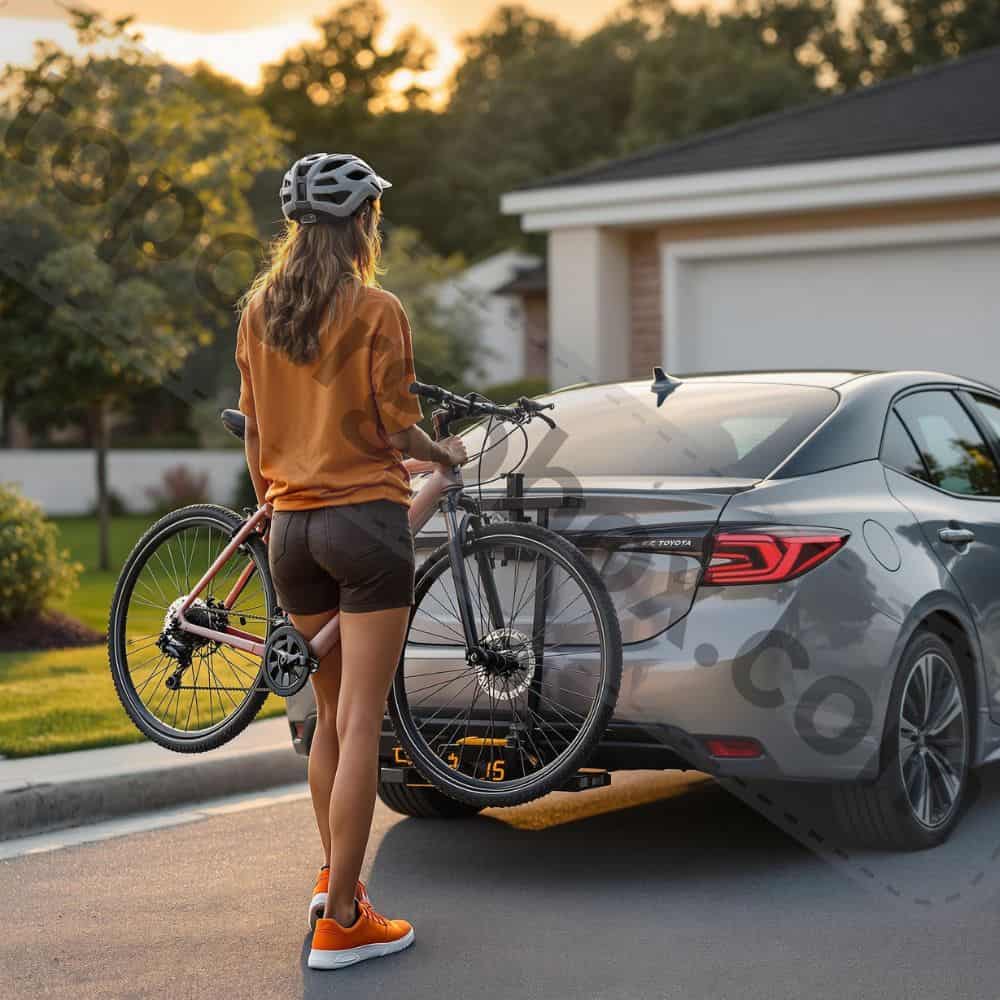
Your Top Bike Rack Questions Answered
What’s the absolute toughest bike rack for my car?
Honestly, if you’re after rock-solid reliability that won’t let you down trip after trip, hitch-mounted racks are usually your best bet. Why? Think about it: they bolt directly onto your car’s frame using the hitch receiver. That means way less wobble and way more security for your precious bikes, especially the heavy ones. Brands like Thule, Yakima, and Kuat are the heavy hitters here – their platform-style racks (think Thule T2 Pro XTR or Yakima RidgeBack are built seriously tough with smart designs that eat up road vibration. Sure, trunk racks like the Saris Bones can work fine, but relying on straps and hoping they grip your car’s shape perfectly? That just adds more spots where things could loosen up or wear out over time. For peace of mind, especially if you’re hauling often or have expensive bikes, a solid hitch rack is the legit champ, as long as your car’s got the hitch for it.
Do bike racks actually free up space inside my car?
For real? Absolutely they do! That’s kinda the whole point, right? No more playing that frustrating game of trying to shove your bike into the backseat or trunk, scratching up your interior and leaving zero room for your gear or buddies. Hitch racks and roof racks keep the bikes completely outside, so your cabin stays totally free. Even trunk racks, while they block your trunk access when loaded, usually fold down super flat or come off entirely when you’re not using them. The real space-saving win comes from racks designed to collapse – like hitch racks folding up vertically or trunk racks folding flat. This makes them way less bulky on your car and a breeze to stash in a tiny garage corner or closet. Compared to the impossible task of fitting bikes inside? Yeah, racks are total space heroes. Check out how to manage carrying bikes without a hitch for more interior-free ideas.
Can my tiny car even handle a bike rack? Seriously?
One hundred percent, yes! Don’t let anyone tell you your compact ride can’t be an adventure mobile. The trick is picking the right rack designed for smaller vehicles. Trunk-mounted racks? Super common and work great on loads of small sedans and hatchbacks – just double-check it fits your specific model. Got a hitch (or can you get one installed)? Even a small 1.25-inch Class I receiver opens up awesome options specifically made for lighter cars and lower weight limits – perfect for racks fitting a Prius or Mini Cooper. Roof racks are doable too if you’ve got rails. Focus on finding racks that are lightweight, have decent ground clearance so they don’t scrape, and fold up small for easy storage. Your small car is totally capable!
Which bike rack is the quickest to pop on and off my car?
If you hate fuss and just want something fast, hitch-mounted racks win this round hands down. Once that hitch receiver is on your car (that part stays put), the rack itself is usually a breeze. We’re talking like 30 seconds: yank out the locking pin, slide the rack out. Done. Need it back on? Slide it in, pop the pin back. Easy peasy. Trunk racks? Nice try, but they involve wrestling with multiple straps, hooking them just right, and tightening everything down each single time – way more fiddly. Roof racks? Forget it; they’re basically semi-permanent fixtures. So, if you only need the rack now and then and don’t want it living on your car, a simple slide-in hitch rack like the Allen Sports Deluxe is your quick-change artist.
Wait, is having a bike rack on my car actually illegal?
Just having the rack itself attached? Nah, that’s usually fine. But – and this is a big ‘but’ – it’s crazy easy to accidentally break the law if your setup blocks important stuff. We’re talking your license plate, tail lights, brake lights, turn signals, or even your rearview mirror vision. Obscuring any of those? That’s almost always a ticket waiting to happen. The key is making sure your rack doesn’t hide any of those critical things. Lots of racks come with little light kits or license plate brackets for exactly this reason – you gotta use them! Rules about how much your bikes can stick out past the bumper also change depending on where you are. It’s definitely not something to brush off; you need to set it up right. Our bike rack laws state-by-state breakdown is super helpful, and we cover the basics of “Is it illegal?” too. Always check your local rules!
What’s the real deal with Thule vs. Buzz Rack?
Okay, think of Thule like the premium, top-shelf brand. They’re Swedish, huge, known for seriously tough materials, cool features (like tool-free adjustments or built-in locks), and they test the heck out of their stuff. You pay more, but you get that peace of mind and slick design. Buzz Rack (often found as Hollywood Racks in the US) is more like the solid, value-focused player. They make racks that work well and cover the basics without the fancy price tag. You might find they use slightly less heavy-duty materials, maybe skip some features like an easy tilt on every model, and just might not feel quite as indestructible as Thule’s best. Buzz Rack is totally legit for the money and great for many riders, but if you want max durability and the latest conveniences and don’t mind spending more, Thule’s the go-to. It’s worth comparing specific models though – sometimes a higher-end Buzz Rack surprises you!
Our team is creating outdoor-gear relevant articles with passion. If our articles can help you to find the correct solutions for your questions, we will be happy about that. In the content creation process, we usually collect accurate and useful information online or offline to compile our content in an organized way. Consequently, we can guarantee that you can discover some expected answers to your questions. We appreciate your time on our site.


